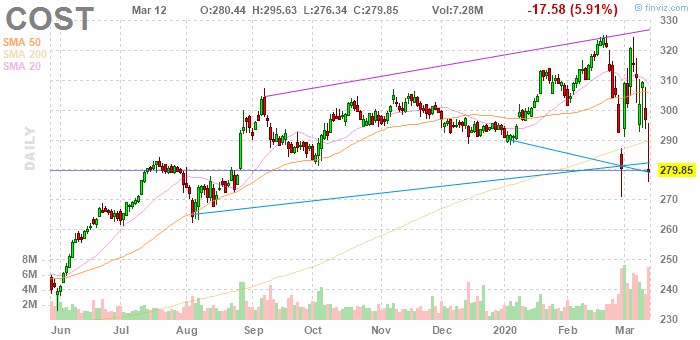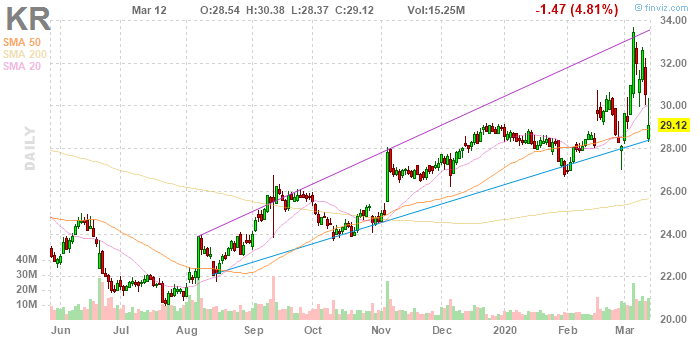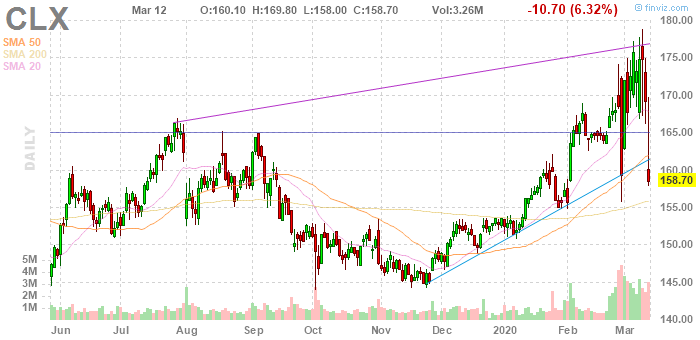As poorly as U.S. stocks have performed, there have been bright spots in the market. In past editions of Big Stock Charts, we’ve tried to highlight some of those bright spots.
After Thursday’s rout, however, it’s almost impossible to do so. Part of the problem is the sheer breadth of the day’s declines.
Of over 1,500 stocks with a market capitalization over $2 billion, only 14 closed in the green Thursday. And after U.S. stocks fell more than 9% in a single session, only 33 have traded higher over the past month. Many of those names are biotechs or other companies that may actually benefit from the spread of the coronavirus.
Friday’s big stock charts focus on three consumer names that had held up relatively well during the sell-off that began in late January. Or at least they had, until Thursday. And while the charts look mixed, Thursday’s declines are unquestionably bad news. These companies should be able to avoid the worst effects of the coronavirus — yet their stock prices are plunging anyway.
Costco (COST)
Costco Wholesale (NASDAQ:COST) would seem like a potential beneficiary of coronavirus fears. Yet the first of Friday’s big stock charts shows a stock clinging to support:
- The technicals look concerning at this point. COST stock is re-testing support that held both in late February (at least relative to its closing price) and in early October. But it’s how the stock has returned to support that might be worrisome. Shares quickly fell through moving averages, including a quick plunge through the 200-day on Thursday. And while the stock didn’t quite close at the lows on Thursday, it came close.
- That trading is somewhat surprising. After all, there’s a case that Costco should benefit from coronavirus fears. Its customers are stocking up across the country. And unlike some grocers, Costco should see a long-term benefit as well, as it picks up new members who presumably will stick around once those fears subside. Add to that a huge opportunity in China as that region gets back to normal, and there’s not an obvious reason why COST stock should be selling off along with the market.
- Except for one: valuation. Even after the pullback, Costco stock trades at almost 30x the consensus earnings per share estimate for next year. Even for a company that seems almost immune to competition from Amazon.com (NASDAQ:AMZN), and one with minimal short-term disruption ahead, that may simply be too high. If it is, that means COST stock is going to keep heading south — and strongly suggests the rest of the market will do the same.
Kroger (KR)
Even after a 4.8% decline on Thursday, Kroger (NYSE:KR) stock has performed reasonably well in 2020. Shares are modestly positive year-to-date, and have rallied 2.4% over the past month. Looking forward, the second of our big stock charts does suggest some optimism if the stock can avoid another decline today:
- For the most part, the chart does look bullish. A broadening ascending wedge still holds if KR can keep above $29; that pattern actually would predict a bounce to new highs. Kroger stock did fall through the 20-day moving average on Thursday, but held the 50-day. Even with recent volatility, this still looks like a stock headed in the right direction.
- That said, there’s not much room for error at the moment. KR can exit the wedge with another decline. It’s only narrowly holding the 50DMA. With U.S. futures pointing to another big decline on Friday, KR may see another sell-off. That would suggest a move to late January support around $27 and then the 200-day below $26.
- In that context, KR is an interesting test case for other defensive names. The stock certainly is cheap enough to see buying, at 12.3x Wall Street EPS estimates for fiscal 2020 (ending January 2021). Coronavirus impacts should be limited; in fact, the company could see a short-term boost from consumers stocking up. Fourth quarter earnings last week impressed the market and sent KR stock soaring. This is the kind of name even nervous investors would consider buying. It would be helpful if they started doing so quickly.
Clorox (CLX)
The story with Clorox (NYSE:CLX) sounds similar to those of Kroger and Costco. The third of our big stock charts shows the technical picture is similar as well:
- Here, too, support needs to hold. CLX stock posted a solid and almost textbook rally from November lows, rising steadily and bouncing repeatedly off the 20-day moving average. But the rally has reversed quickly. The stock has posted bearish tests of both the 20-day and the 50-day. CLX now has exited a narrowing ascending wedge, and the last line of support seems to be the 200-day moving average. If CLX breaches that level, the stock could be in trouble.
- As Josh Enomoto detailed last week, the coronavirus seems to be a positive near-term catalyst for Clorox, as it is for Costco. Whether it’s a return to bleach ahead of ‘natural’ and/or ‘organic’ but less-effective products, or increased sales of disinfecting wipes, nervous consumers should buy more Clorox products for at least the next few months. That tailwind may not fade, either. Yet, as with Costco, investors are selling the stock anyway.
- Valuation is a question. CLX trades at 24x forward earnings despite relatively modest earnings growth. That’s not an unreasonable multiple relative to other defensive large-cap consumer plays like Procter & Gamble (NYSE:PG) and Colgate-Palmolive (NYSE:CL). But it is a multiple that’s exceptionally relatively high on a historical basis. And so the decline in CLX stock may suggest a significant, permanent re-rating of the entire sector, rather than just a panic-driven sell-off.
Vince Martin has covered the financial industry for close to a decade for InvestorPlace.com and other outlets. He has no positions in any securities mentioned.



